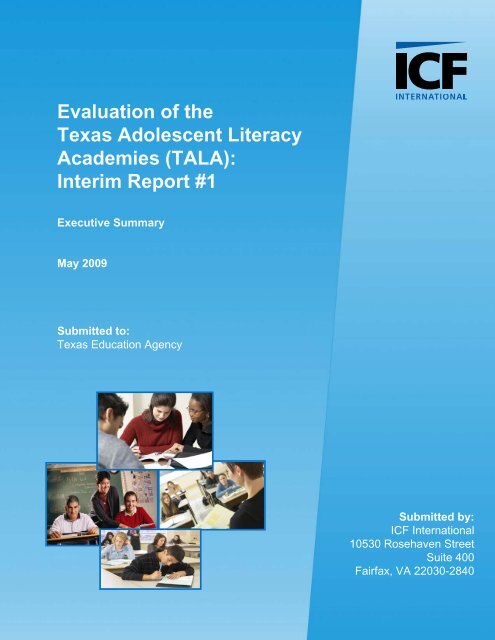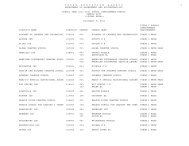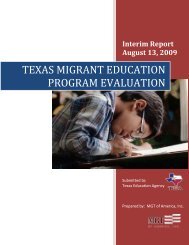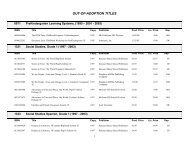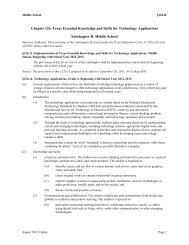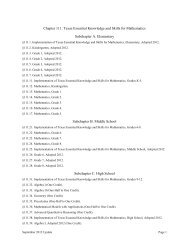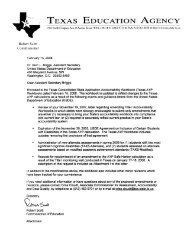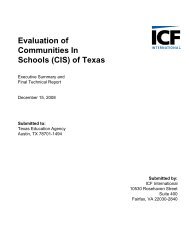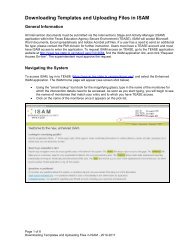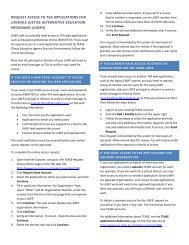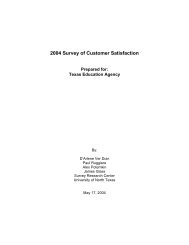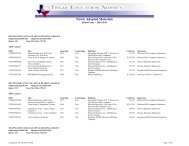Evaluation of the Texas Adolescent Literacy Academies (TALA ...
Evaluation of the Texas Adolescent Literacy Academies (TALA ...
Evaluation of the Texas Adolescent Literacy Academies (TALA ...
- No tags were found...
Create successful ePaper yourself
Turn your PDF publications into a flip-book with our unique Google optimized e-Paper software.
<strong>Evaluation</strong> <strong>of</strong> <strong>the</strong><strong>Texas</strong> <strong>Adolescent</strong> <strong>Literacy</strong><strong>Academies</strong> (<strong>TALA</strong>):Interim Report #1Executive SummaryMay 2009Submitted to:<strong>Texas</strong> Education AgencySubmitted by:ICF International10530 Rosehaven StreetSuite 400Fairfax, VA 22030-2840
<strong>Texas</strong> <strong>Adolescent</strong> <strong>Literacy</strong> <strong>Academies</strong> (<strong>TALA</strong>): Interim <strong>Evaluation</strong> Report #1CREDITS ICF InternationalICF International partners with government and commercial clients to deliver consulting services and technologysolutions in <strong>the</strong> social programs, health, energy, climate change, environment, transportation, defense, andemergency management markets.The firm combines passion for its work with industry expertise and innovative analytics to produce compelling resultsthroughout <strong>the</strong> entire program life cycle, from analysis and design through implementation and improvement.For additional information about ICF, please contact:ICF InternationalTracy Roberts9300 Lee Highway, Fairfax, VA 22031-1207 USAPhone: 1.703.934.3603 or 1.800.532.4783Fax: 1.703.934.3740E-mail: info@icfi.comAuthors & Project ContributorsRosemarie O’Conner, PhD Brian Cronin, PhDThomas J. HorwoodCandace Cronin, PhDJocelyn Vas Andrea ArthurKathleen WangCarol Kozak Hawk, PhDFrances Burden, PhDChristine Lagana-RiordanAmy Mack, PsyDMary Robbins, EdDJulie GdulaDebra Price, PhDJessica ZumdahlJacqueline SchmidtTracy RobertsMaureen Murphy, EdDSarah DeckerSeri Irazola, PhDPrepared for<strong>Texas</strong> Education Agency1701 North Congress AvenueAustin, <strong>Texas</strong> 78701-1494Phone: 512-463-9734Research Funded by<strong>Texas</strong> Education Agency
<strong>Texas</strong> <strong>Adolescent</strong> <strong>Literacy</strong> <strong>Academies</strong> (<strong>TALA</strong>): Interim <strong>Evaluation</strong> Report #1COPYRIGHT NOTICE Copyright © Notice The materials are copyrighted © and trademarked as <strong>the</strong> property <strong>of</strong> <strong>the</strong> <strong>Texas</strong> EducationAgency (TEA) and may not be reproduced without <strong>the</strong> express written permission <strong>of</strong> TEA, except under <strong>the</strong> followingconditions:1) <strong>Texas</strong> public school districts, charter schools, and Education Service Centers may reproduce and use copies <strong>of</strong><strong>the</strong> Materials and Related Materials for <strong>the</strong> districts’ and schools’ educational use without obtaining permissionfrom TEA.2) Residents <strong>of</strong> <strong>the</strong> state <strong>of</strong> <strong>Texas</strong> may reproduce and use copies <strong>of</strong> <strong>the</strong> Materials and Related Materials for individualpersonal use only without obtaining written permission <strong>of</strong> TEA.3) Any portion reproduced must be reproduced in its entirety and remain unedited, unaltered and unchanged in anyway.4) No monetary charge can be made for <strong>the</strong> reproduced materials or any document containing <strong>the</strong>m; however, areasonable charge to cover only <strong>the</strong> cost <strong>of</strong> reproduction and distribution may be charged.Private entities or persons located in <strong>Texas</strong> that are not <strong>Texas</strong> public school districts, <strong>Texas</strong> Education ServiceCenters, or <strong>Texas</strong> charter schools or any entity, whe<strong>the</strong>r public or private, educational or non-educational, locatedoutside <strong>the</strong> state <strong>of</strong> <strong>Texas</strong> MUST obtain written approval from TEA and will be required to enter into a licenseagreement that may involve <strong>the</strong> payment <strong>of</strong> a licensing fee or a royalty.For information contact: Office <strong>of</strong> Copyrights, Trademarks, License Agreements, and Royalties, <strong>Texas</strong> EducationAgency, 1701 N. Congress Ave., Austin, TX 78701-1494; phone 512-463-9270 or 512-936-6060; email:copyrights@tea.state.tx.us.ii
<strong>Texas</strong> <strong>Adolescent</strong> <strong>Literacy</strong> <strong>Academies</strong> (<strong>TALA</strong>): Interim <strong>Evaluation</strong> Report #1Executive Summary According to several reading researchers and government agencies, <strong>the</strong>re is a literacy crisis inmiddle schools across <strong>the</strong> United States (e.g., Kamil, Borman, Dole, Kral, Salinger, & Torgesen,2008; Slavin, Chamberlain, & Daniels, 2007). Over 70 percent <strong>of</strong> adolescents struggle to readand enter high school reading below grade level (Alliance for Excellent Education, 2003;NASBE, 2006). Approximately two-thirds <strong>of</strong> eighth grade students read below <strong>the</strong> pr<strong>of</strong>icient levelon <strong>the</strong> National Assessment <strong>of</strong> Educational Progress (NAEP) and one-quarter read below <strong>the</strong>basic level (NASBE, 2006). In <strong>Texas</strong>, TAKS passing rates decrease in middle school. Sincepoor readers are at a greater risk for dropping out <strong>of</strong> high school (Snow & Biancarosa, 2003),adolescent literacy has become a “hot topic” for research and intervention (Cassidy & Cassidy,2007). Additionally, research indicates that students with average reading ability are unpreparedfor reading in post-secondary education and <strong>the</strong> workforce (Kamil et al., 2008). The middleschool years <strong>of</strong>fer <strong>the</strong> last chance to build <strong>the</strong> foundation <strong>of</strong> literacy skills for high schoolsuccess (Slavin et al., 2007).Explicit instruction in four key areas has been found to lead to reading improvement: (1)phonics, (2) fluency, (3) vocabulary, and (4) comprehension. In addition, instruction that focuseson only one component <strong>of</strong> reading is not sufficient to promote literacy in struggling readers.Phonics, fluency, and vocabulary are factors necessary for reading comprehension to occur. Asa result, an emphasis on comprehension strategies alone will not increase reading ability,especially in students who are struggling readers. The inclusion <strong>of</strong> multiple reading componentswithin <strong>the</strong> same intervention has been found to be <strong>the</strong> most effective to improve readingachievement (Scammacca, Vaughn, Edmonds, Reutebuch, & Torgesen, 2007).Response-to-Intervention (RTI) is a multi-tiered instructional model for educational assessmentand intervention delivery. It is based on student progress data, which inform whe<strong>the</strong>r increasinglevels <strong>of</strong> intervention delivery should be provided to students who are not responding to <strong>the</strong>ircurrent program <strong>of</strong> instruction (Colorado State Department <strong>of</strong> Education, 2006; Fuchs & Fuchs,1998; Fuchs & Vaughn, 2006; NASDSE, 2006). Many RTI models apply a three-tiered approachthat entails primary (or universal), secondary, and tertiary instruction. Each level is synonymouswith a tier and student movement among <strong>the</strong>m is typically informed by progress monitoring data.Tier 1 should be characterized as high-quality (i.e., research-based) instruction provided to allstudents. Tier 2 instruction is not universal, but utilized for those students who do makeadequate progress in reading after working with core curricula. Students who do not respondsufficiently to Tier 2 intervention enter Tier 3, which typically involves more comprehensiveevaluation and intense services and might apply to about 5 percent <strong>of</strong> studentsResearch and evaluation on reading initiatives at <strong>the</strong> federal (e.g., Reading First) and statelevels indicate that <strong>the</strong>re is much to be done in order to close <strong>the</strong> achievement gap for learnersin reading (Alliance for Excellent Education, 2003; NASBE, 2006). Funding to close <strong>the</strong>achievement gap in reading has been focused on training and preparation <strong>of</strong> reading teachers,remediation for students reading below grade level, and an emphasis on early literacystrategies, including <strong>the</strong> promotion <strong>of</strong> family literacy. Over <strong>the</strong> last 12 years, <strong>Texas</strong> has focusedon improving reading instruction in order to improve overall reading achievement for students atall grade levels. The most recent initiative is <strong>the</strong> <strong>Texas</strong> <strong>Adolescent</strong> <strong>Literacy</strong> <strong>Academies</strong> (<strong>TALA</strong>).1
About <strong>TALA</strong><strong>Texas</strong> <strong>Adolescent</strong> <strong>Literacy</strong> <strong>Academies</strong> (<strong>TALA</strong>): Interim <strong>Evaluation</strong> Report #1<strong>Texas</strong> House Bill 2237 was created in 2007 in order to improve high school success andincrease college readiness in <strong>Texas</strong> public schools, and provided specific direction and fundingfor <strong>TALA</strong>. <strong>TALA</strong> was created to improve literacy rates among middle school students. In order toachieve this goal, <strong>TALA</strong> focuses on improving teaching, ra<strong>the</strong>r than directly on students, byproviding Grades 6-8 English language arts (ELA)/reading and content area teachers withsuccessful, research-based strategies for improving <strong>the</strong>ir students’ academic literacy.The <strong>TALA</strong> Model<strong>TALA</strong> instructional routines represent scientifically-based instructional strategies based onreading research. The emphasis is on implementation <strong>of</strong> a three-tier reading model consistentwith an RTI model. This model emphasizes ongoing data collection and immediate interventionfor students who demonstrate a need in one or more reading skills. <strong>TALA</strong> is tailored for <strong>the</strong>unique structure <strong>of</strong> middle schools and is framed within a school-wide approach to addressing<strong>the</strong> needs <strong>of</strong> struggling adolescent readers.The goal <strong>of</strong> <strong>TALA</strong> is to provide pr<strong>of</strong>essional development for ELA/reading and content areateachers in <strong>the</strong> use <strong>of</strong> scientifically-based literacy practices to improve academic literacy. <strong>TALA</strong>is intended to help prepare middle school teachers to design appropriate instruction for allstudents, including those who are struggling with reading due to limited English pr<strong>of</strong>iciency(LEP), learning disabilities, dyslexia, and o<strong>the</strong>r risk factors for reading difficulties.The <strong>TALA</strong> program consists <strong>of</strong> two separate academies: <strong>the</strong> ELA Academy and Content AreaAcademy. The ELA Academy is designed for reading and English language arts teachers. TheContent Area Academy targets math, science, and social studies teachers. Both academiesprovide pr<strong>of</strong>essional development in scientifically-based, general literacy instructional strategies.The ELA Academy also provides training in <strong>the</strong> use <strong>of</strong> a diagnostic and progress monitoringassessment and reading intervention instructional strategies.The Format <strong>of</strong> <strong>TALA</strong>The ELA <strong>Academies</strong> consist <strong>of</strong> three days <strong>of</strong> face-to-face training, followed by a one-day onlinepracticum follow-up. The Content Area <strong>Academies</strong> consisted <strong>of</strong> 1.5 days <strong>of</strong> face-to-face training,followed by a half-day online practicum. <strong>TALA</strong> trainers provided examples <strong>of</strong> <strong>the</strong> strategies and<strong>the</strong>ir applications, both in hard copy and video formats, with appropriate subject area materialsin <strong>the</strong> middle school classroom. The content is organized into seven units with individualmodules that last between 30 and 75 minutes. Units 1-3 were covered in both ELA and ContentArea <strong>Academies</strong>, while units 4-7 were only covered in <strong>the</strong> ELA <strong>Academies</strong>.Implementation <strong>of</strong> <strong>TALA</strong>Regional Education Service Center (ESC) leaders were in charge <strong>of</strong> operations for <strong>the</strong>implementation <strong>of</strong> <strong>TALA</strong> statewide. The <strong>Texas</strong> Education Agency established education servicecenters to serve as a first point <strong>of</strong> contact for school districts, parents, and o<strong>the</strong>r communitystakeholders, and to provide leadership, training, and technical assistance. The ESC leadersscheduled <strong>TALA</strong> ELA and Content Area <strong>Academies</strong> in <strong>the</strong>ir respective regions, establishedlocations, set dates and times, and worked with <strong>the</strong>ir IT staff to set up <strong>the</strong> registrationinformation in <strong>the</strong>ir catalog and develop a registration database to track participants.2
<strong>Texas</strong> <strong>Adolescent</strong> <strong>Literacy</strong> <strong>Academies</strong> (<strong>TALA</strong>): Interim <strong>Evaluation</strong> Report #1For this report on Phase One <strong>of</strong> <strong>the</strong> <strong>TALA</strong> program evaluation, researchers conducted a series<strong>of</strong> exploratory and descriptive analyses to understand <strong>the</strong> distributional properties <strong>of</strong> survey andobservation data. This quantitative data were mixed with qualitative findings and contentanalyses to generate overall statements about <strong>the</strong> quality <strong>of</strong> <strong>TALA</strong> trainings, stakeholderperceptions, and budget allocations.Phase One FindingsExpert Review <strong>of</strong> Materials<strong>TALA</strong> instructional strategies were perceived by <strong>the</strong> Technical Advisory Board (TAB) membersas important and necessary for adolescent readers. The routines require active teaching by <strong>the</strong>teacher, high levels <strong>of</strong> student participation, and require <strong>the</strong> students to become “morecognitively engaged in learning.” Many <strong>of</strong> <strong>the</strong> instructional routines are representative <strong>of</strong> bestpractices in literacy and scientifically-based research practices. The TAB recommended that, inorder to improve <strong>the</strong> implementation <strong>of</strong> <strong>TALA</strong> in <strong>the</strong> schools, teachers need systemic supportfrom reading coaches and school administrators, on-going training, classroom follow-up, andopportunities to practice <strong>the</strong> routines with feedback. In addition, <strong>the</strong> TAB members suggestedthat teachers should see models in <strong>the</strong> classroom, during and after <strong>the</strong> training. Lastly, <strong>the</strong> TABmembers felt that <strong>the</strong> trainers should use actual texts in training so <strong>the</strong> teachers will see how <strong>the</strong>material will work in <strong>the</strong>ir classrooms and to make sure that teachers are exposed to a largenumber <strong>of</strong> instructional routines that are taught in conjunction with <strong>the</strong>ir texts. In o<strong>the</strong>r words,this would help teachers learn how to fuse <strong>the</strong> content with <strong>the</strong> strategies.Observations <strong>of</strong> <strong>TALA</strong> TrainingThe <strong>TALA</strong> Regional TOT and <strong>TALA</strong> Classroom Teacher <strong>Academies</strong> were highly rated byobservers. Trainers at <strong>the</strong> Regional TOT and Classroom Teacher <strong>Academies</strong> were able toeffectively implement <strong>the</strong> components <strong>of</strong> <strong>the</strong> <strong>TALA</strong> training. In both trainings, <strong>the</strong>presenters/trainers explained and reviewed <strong>TALA</strong> content, provided examples and elaborations,and distributed and used <strong>the</strong> handouts. Both trainings (Regional TOT and Classroom Teacher<strong>Academies</strong>) had lesser occurrences <strong>of</strong> modeling <strong>the</strong> routines and having <strong>the</strong> participantspractice <strong>the</strong> routines independently or with each o<strong>the</strong>r. The trainers were less likely to use <strong>the</strong>videos in <strong>the</strong> Classroom Teacher <strong>Academies</strong>.Regional and Classroom Teacher <strong>Academies</strong> were rated as being reflective <strong>of</strong> best practices forpr<strong>of</strong>essional development and <strong>the</strong> culture <strong>of</strong> <strong>the</strong> training sessions facilitated <strong>the</strong> engagement <strong>of</strong>participants in <strong>the</strong> <strong>TALA</strong> training. However, observers were hesitant to report that <strong>the</strong> RegionalTOT prepared participants to present <strong>the</strong> <strong>TALA</strong> training. For example, observers ratedperceived preparation as low for “working with adult learners” and “differentiation <strong>of</strong> instructionfor various learning styles.”Observers rated <strong>the</strong> <strong>TALA</strong> Regional TOT as exhibiting high implementation, following <strong>the</strong>activities and content as presented in <strong>the</strong> training materials. This rating is reflected in perceivedpreparedness <strong>of</strong> regional trainers to present <strong>the</strong> activities as outlined in <strong>the</strong> training. Also, <strong>the</strong>culture <strong>of</strong> <strong>the</strong> Regional TOT was perceived as positive as well as <strong>the</strong> perception <strong>of</strong> regionaltrainers to maintain a positive learning environment. However, <strong>the</strong>re was less implementation <strong>of</strong><strong>the</strong> TEKS and TAKS in <strong>the</strong> Regional TOT and observers reported lower beliefs that <strong>the</strong> trainingbuilt participants’ skill in linking <strong>the</strong>ir instruction to <strong>the</strong> TEKS and developed participants’understanding <strong>of</strong> <strong>the</strong> TAKS student assessment system.4
Perceptions <strong>of</strong> <strong>TALA</strong> Training<strong>Texas</strong> <strong>Adolescent</strong> <strong>Literacy</strong> <strong>Academies</strong> (<strong>TALA</strong>): Interim <strong>Evaluation</strong> Report #1Both state and regional trainers had positive perceptions <strong>of</strong> <strong>the</strong> <strong>TALA</strong> training. The majority <strong>of</strong>trainers had <strong>the</strong> prerequisite skills needed to conduct <strong>the</strong> training (e.g., previous experience asa teacher, previous pr<strong>of</strong>essional development experience). The overall impressions <strong>of</strong> <strong>the</strong>training that <strong>the</strong>y attended to become a <strong>TALA</strong> trainer were favorable, reporting that <strong>the</strong> trainingwas effective in helping <strong>the</strong>m prepare for <strong>the</strong>ir role as a trainer. The trainers felt adequatelyprepared for <strong>the</strong> training that <strong>the</strong>y conducted based on <strong>the</strong> training that <strong>the</strong>y attended. The oneissue that emerged in both state and regional trainer perceptions was <strong>the</strong> need for moretime/additional days to learn and present <strong>the</strong> <strong>TALA</strong> content due to <strong>the</strong> large amount <strong>of</strong> materialcovered in <strong>the</strong> training.Discussion and Next Steps for <strong>TALA</strong>The overall findings <strong>of</strong> Phase One <strong>of</strong> <strong>the</strong> <strong>TALA</strong> evaluation provide evidence that <strong>TALA</strong> contentis representative <strong>of</strong> best practices for literacy instruction and is explicitly aligned to national andstate standards in English Language Arts (ELA) and Reading. Evidence is also presented for<strong>the</strong> effective implementation <strong>of</strong> <strong>TALA</strong> routines at all levels <strong>of</strong> training (state, regional, andclassroom teacher). The <strong>TALA</strong> training had a positive climate, conducive to learning. Thetraining <strong>of</strong> trainers prepared <strong>the</strong> state and regional trainers well for <strong>the</strong>ir role as a <strong>TALA</strong> trainer.Phase Two <strong>of</strong> <strong>the</strong> evaluation will assess whe<strong>the</strong>r <strong>TALA</strong> classroom teacher academies led to achange in teaching practices and if <strong>the</strong> <strong>TALA</strong> influence student achievement. Finally, <strong>the</strong> costeffectivenessand sustainability <strong>of</strong> <strong>TALA</strong> will be assessed in Phase Two.5


